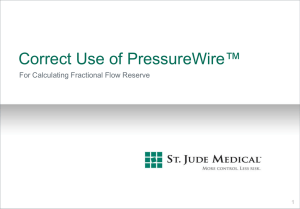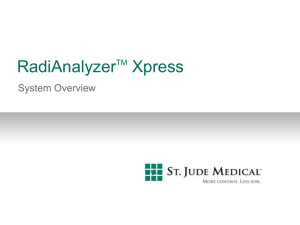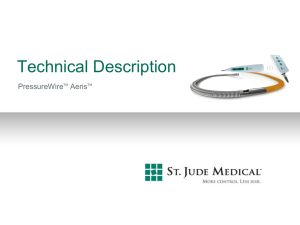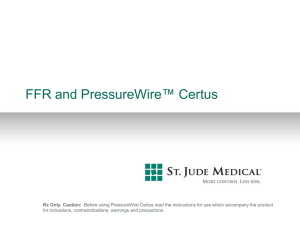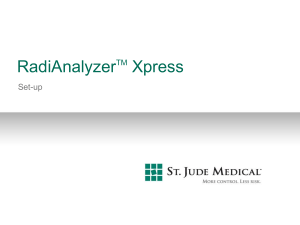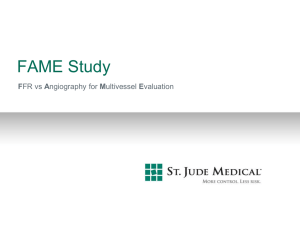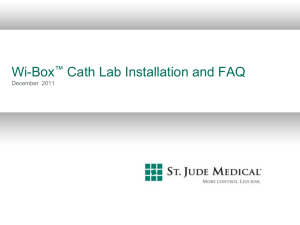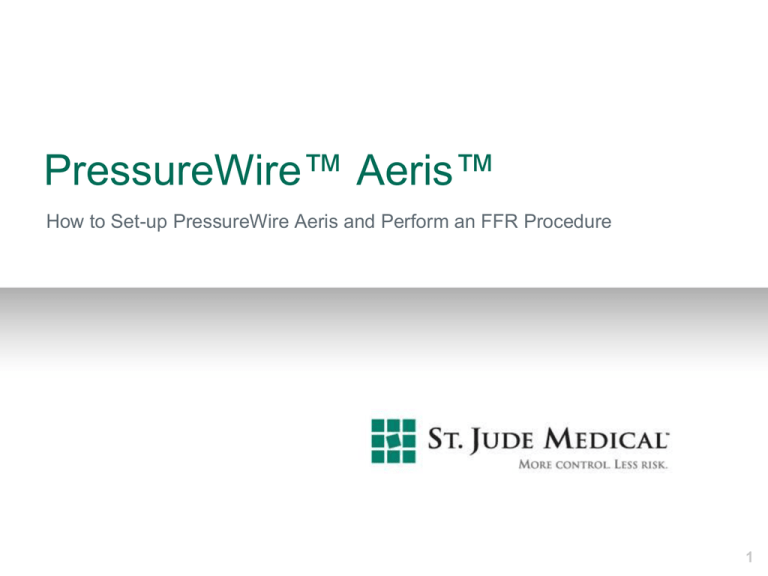
PressureWire™ Aeris™
How to Set-up PressureWire Aeris and Perform an FFR Procedure
1
Installation
1. Mount PressureWire Receiver
Assemble bracket to fit rail or pole; see illustration
Fasten PressureWire Receiver on the cath lab table rail or on a vertical pole
PressureWire Receiver should preferably be placed in line of sight where
PressureWire Aeris will be used and not more than 2 m away.
Vertical pole
2
Horizontal equipment rail
Installation
2. Connect PressureWire Receiver and AO transducer
Connect PressureWire Receiver to a free pressure channel on the hemodynamic
recording system, preferably P2-P4.
Verify that there is a steady yellow light, indicating that PressureWire Receiver is
connected correctly and powered by the pressure channel module.
Connect the AO transducer to another pressure channel, preferably P1.
PressureWire Receiver
Pressure input module
P2
AO-transducer
P1
3
Installation
3. Zero all Pressure Channels
Open AO to air and zero both pressure channels P1 and P2, P3 or P4
4
FFR Procedure
4. Prepare PressureWire Aeris
5
Remove the pouch from the box
Remove PressureWire Aeris
Place the tray flat
Follow printed illustrations on the tray to prepare PressureWire Aeris for use
FFR Procedure
4. Prepare PressureWire Aeris
6
1. Flush coil with saline
2. Loosen torque device 3. Open holding flaps
Fill coil with saline, take care not to expose
PressureWire Transmitter to fluids.
Make sure to pull torque device
forward along the wire, do not
bend loose.
Carefully tear open the flaps holding
PressureWire Transmitter to the tray.
FFR Procedure
4. Prepare PressureWire Aeris
4. Remove PressureWire 5. Activate PressureWire 6. Turn on PressureWire
Transmitter
Lift PressureWire Transmitter up and
place it on the bed next to the tray
without removing the wire from coil.
Make sure PressureWire is fully
inserted into PressureWire Transmitter.
7
Receiver
Activate PressureWire Receiver
by pressing quickly on the center
Connect button. The green lights
should blink signaling that PressureWire
Receiver is waiting
for a connection .
Transmitter
Turn on PressureWire Transmitter
by pushing the slide button forward.
PressureWire Aeris will now zero
and connect to PressureWire
Receiver. PressureWire Aeris is now
ready for use.
FFR Procedure
5. Equalize AO and PressureWire Aeris
Advance the wire to the tip of the guiding catheter.
Adjust the height of the AO transducer so that it matches the
height of the patient’s heart (mid axillary).
Remove introducer needle, close hemostatic valve and flush any
remaining contrast from catheter.
Equalize any residual pressure difference between PressureWire
and AO using the plus and minus buttons on PressureWire
Receiver.
Note: Each time a plus or minus button is pushed PressureWire
pressure is increased or decreased 1 mmHg.
8
FFR Procedure
6. Record and Calculate FFR
Advance PressureWire sensor distally in the coronary artery
Induce long-lasting maximum hyperemia using the cath lab’s standard clinical practice
Start recording by clicking on the “record” button or equivalent, on recording system
Stop recording at maximum hyperemia and review recording on screen.
9
FFR Procedure
6. Record and Calculate FFR (continued)
Pamean
Pdmean
FFR=Pd/Pa
During maximum hyperemia
Most recording systems have a cursor which can be moved over
the graph to enable reading of pressure values
Make sure to use the mean pressure values for Pa and Pd
10
Summary
Installation
1.
Mount PressureWire Receiver
2.
Connect PressureWire Receiver and AO transducer to the hemodynamic recording system
3.
Verify pressure balance between PressureWire Receiver and hemodynamic system
FFR procedure
11
1.
Open AO to air and Zero all pressure channels on recording system
2.
Prepare PressureWire Aeris and turn on to zero and sync with PressureWire Receiver
3.
Equalize AO and PressureWire Aeris using buttons on PressureWire Receiver
4.
Record and calculate the FFR result from pressure tracings on screen or paper
Switch off PressureWire transmitter after use
Miscellaneous
Re-calibration/Re-zero
• If the wire needs to be re-calibrated or re-zeroed it must first be taken out of the body and placed
in the packaging coil with saline. Place the packaging coil flat.
• Calibrate the wire by re-starting the transmitter: push the slider backward and then forward
again.
• If the pressure is still not zero after re-calibration – zero the pressure channel on the
hemodynamic recording system.
Verify recording system and PressureWire Receiver balance
• Press the center Connect button for more than 3 seconds to enter RefOut mode.
• By pressing the Plus/Minus keys, different reference pressure levels can be set according to: 0;
20; 40; 100; 200 mmHg. Set level is indicated by the green LED’s on the front of PressureWire
Receiver.
• Verify that the hemodynamic recording system is displaying the same pressure levels as set by
PressureWire Receiver.
• If the pressures mismatch by more than 1%, contact the cath lab technicians to verify the
calibration of the hemodynamic recording system.
• Exit RefOut mode by pressing shortly again on the Connect button.
Rx Only
Please review the Instructions for Use prior to using these devices for a complete listing of
indications, contraindications, warnings, precautions, potential adverse events and
directions for use.
Product referenced is approved for CE Mark.
PressureWire is designed, developed and manufactured by St. Jude Medical Systems AB.
PressureWire Aeris, RADI, ST. JUDE MEDICAL, the nine-squares symbol and MORE
CONTROL. LESS RISK. are registered and unregistered trademarks and service marks of
St. Jude Medical, Inc. and its related companies. ©2011 St. Jude Medical, Inc. All rights
reserved

